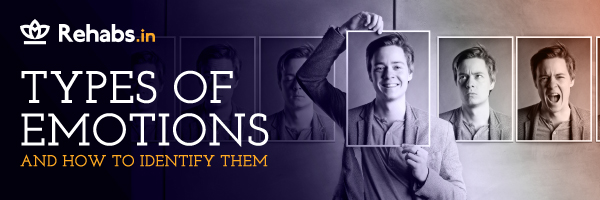Types of emotions and how to identify them

What are emotions?
We’ve all experienced emotions and continue to do so in every moment of our lives. At some points, we might even feel more than one emotion at a time, sometimes also contradictory emotions. Sometimes our emotions might be more intense, like when you first spoke to your crush and felt elated sometimes, they may be more moderate, like after you take a relaxing shower every morning.
Emotions are a part of our response to different events. These events might be external, actually happening in the real world, or internal, like when you think about your memories or create a dreamy imagination. Different situations may trigger different emotions.
According to psychologists, emotions are interconnected with our thoughts and our behaviour. We tend to act differently and think differently when we are happy vs when we are angry. Understanding these emotions can help us manage them better and understand ourselves better. This can improve our relationships, our mental health and our resilience. Understanding our own emotions can also help us better empathise with others.
Different types of emotions
Each of us experiences different emotions somewhat differently. Any situation can lead to more intense emotions in one person and have no effect on the other. So it is important to understand our own emotions in depth. Let’s first discuss the six primary emotions. We’ve seen about five of these in the movie ‘Inside out’.
- Happiness: seen as a positive emotion characterised by joy and pleasure. It is usually experienced when there are positive events like spending time with loved ones, doing something you enjoy, achieving a goal etc. People often feel light and express happiness through a smile on their faces and joy in their eyes. It is an emotion people often wish was permanent. But like every other emotion, happiness is fleeting.
- Sadness: seen as a negative emotion and characterised by feelings of loss, grief or unhappiness. It is often experienced when something unpleasant or negative happens. For example, failure to achieve a goal, fighting with your partner, or losing a loved one. People often try to run away from this feeling. But, like all other emotions, it has its own functions. It is a good idea to sit with yourself and give yourself time to process this emotion.
- Fear: This emotion is characterised by feelings of anxiety or dread. Fear comes up when one feels that they’re in a threatening or dangerous situation. This might activate the flight or fight response in people. Experiencing fear can be discomforting but is important for survival.
- Disgust: Characterized by feelings of aversion or repulsion. It is often triggered when one comes across something distasteful or extremely unpleasant. Like a dirty house, foul smell, bad food, or offensive behaviour. People might feel repulsive when experiencing this emotion.
- Anger: Anger is characterised by feelings of annoyance or frustration. One might get irritated when something unfair happens, due to which they feel like they’ve been treated poorly. This is a protective emotion but is largely looked down upon. This emotion is important, like all other emotions. The way in which it is expressed can be healthy or unhealthy.
- Surprise: This feeling is characterised by feelings of amazement or astonishment. It may be triggered by positive or negative events. It often comes up when something unexpected happens.
It is believed that these primary emotions are universal. They are experienced by people of all different ages and cultures all across the world. These emotions arise automatically when a triggering event occurs. All of these emotions also have certain physiological characteristics that depend on the intensity of the emotion. For example, disgust can make you feel nauseous, anger can lead to rapid breathing, happiness can lead to changes in heart rate etc.
A famous psychologist, Plutchik, developed a model called the Wheel of Emotions that shows how different emotions overlap and inter-relate with each other. It has eight primary emotions and eight secondary emotions as seen in the picture below.
Wheel of emotions by Plutchik.
The eight primary emotions, according to Plutchik, are joy, trust, fear, sadness, surprise, anger, disgust and anticipation. These emotions are considered to be universal. These blend with other emotions, like primary colours, blend to form secondary colours. These secondary emotions include awe, disapproval, remorse, contempt, aggressiveness, optimism, love, and submission.
How to identify emotions
Identifying or labelling our emotions is often an essential first step in the process of therapy. Labelling emotions is simply trying to assess and identify how you feel and being able to express it. People can use a reference list of emotions or the emotions wheel to guide them in doing so.
However, this isn’t so easy. Many of us would have at some point said, “it’s difficult to express exactly what I feel,” or “I am not sure how I feel.” Many a time, when asked how they feel, people tend to respond with the words “good”, “okay”, or “bad.” In our culture, we are not taught to understand these emotions.
There is a sort of stigma attached to expressing emotions. You’d have heard people say, “she’s so emotional,” “men don’t cry,” or “don’t show your emotions, or they’ll think you’re weak.” Due to this notion, people often feel guilty about feeling or expressing intense emotions.
Suppressing emotions is somewhat encouraged due to this stigma. However, it is counter-intuitive. Bottling up our emotions can be harmful to our health and well-being. Due to this, you might develop more physiological signs of stress. The next step after identifying the emotion is understanding how to express our emotions healthily.
Rejecting or suppressing our emotions can leave you feeling uneasy and overwhelmed. All emotions are fleeting, and they come and go. Labelling our emotions can help us in the process of emotional regulation. One way to develop this habit is journaling.
You can create a separate journal to write about emotional events. Explain how you felt physically and mentally in the situation. You can also use the emotions wheel to help you use the right words. This can help you broaden your emotional vocabulary. After labelling the emotion, see what other words you can use to describe your feeling.
This method helps us process our emotions rather than burying them. It is important to process both positive and negative emotions. It can also encourage us to be in the moment with ourselves, giving us a new perspective on things. Practising labeling our emotions can help improve our emotional intelligence and our ability to connect with ourselves and others.
Sources:
Izard, C. E. (2009). Emotion Theory and Research: Highlights, Unanswered Questions, and Emerging Issues. Annual Review of Psychology, 60(1), 1–25. https://doi.org/10.1146/annurev.psych.60.110707.163539
Mohsin, M. A., & Beltiukov, A. P. (2019). Summarizing Emotions from Text Using Plutchik’s Wheel of Emotions. Proceedings of the 7th Scientific Conference on Information Technologies for Intelligent Decision Making Support (ITIDS 2019). https://doi.org/10.2991/itids-19.2019.52
Ortony, A., & Turner, T. (1990). What’s basic about basic emotions? Psychological Review, 97(3), 315–331. https://doi.org/10.1037/0033-295x.97.3.315














